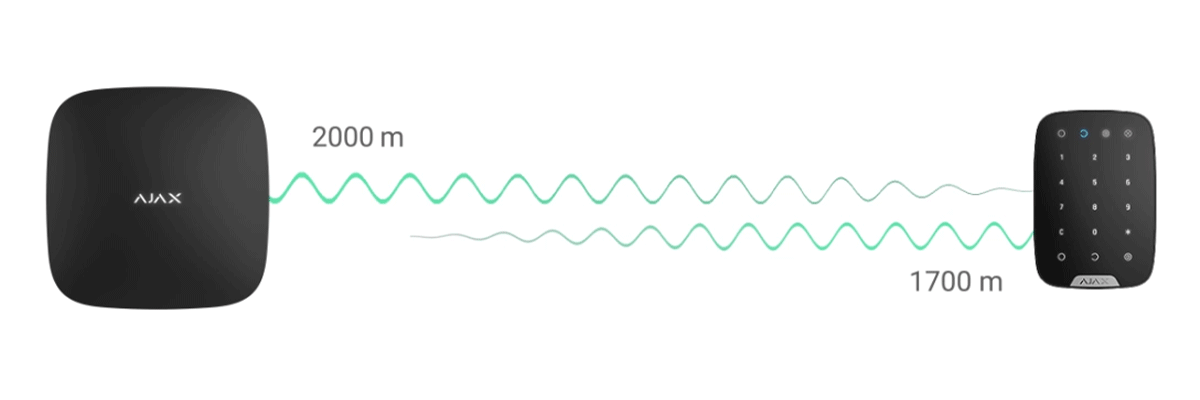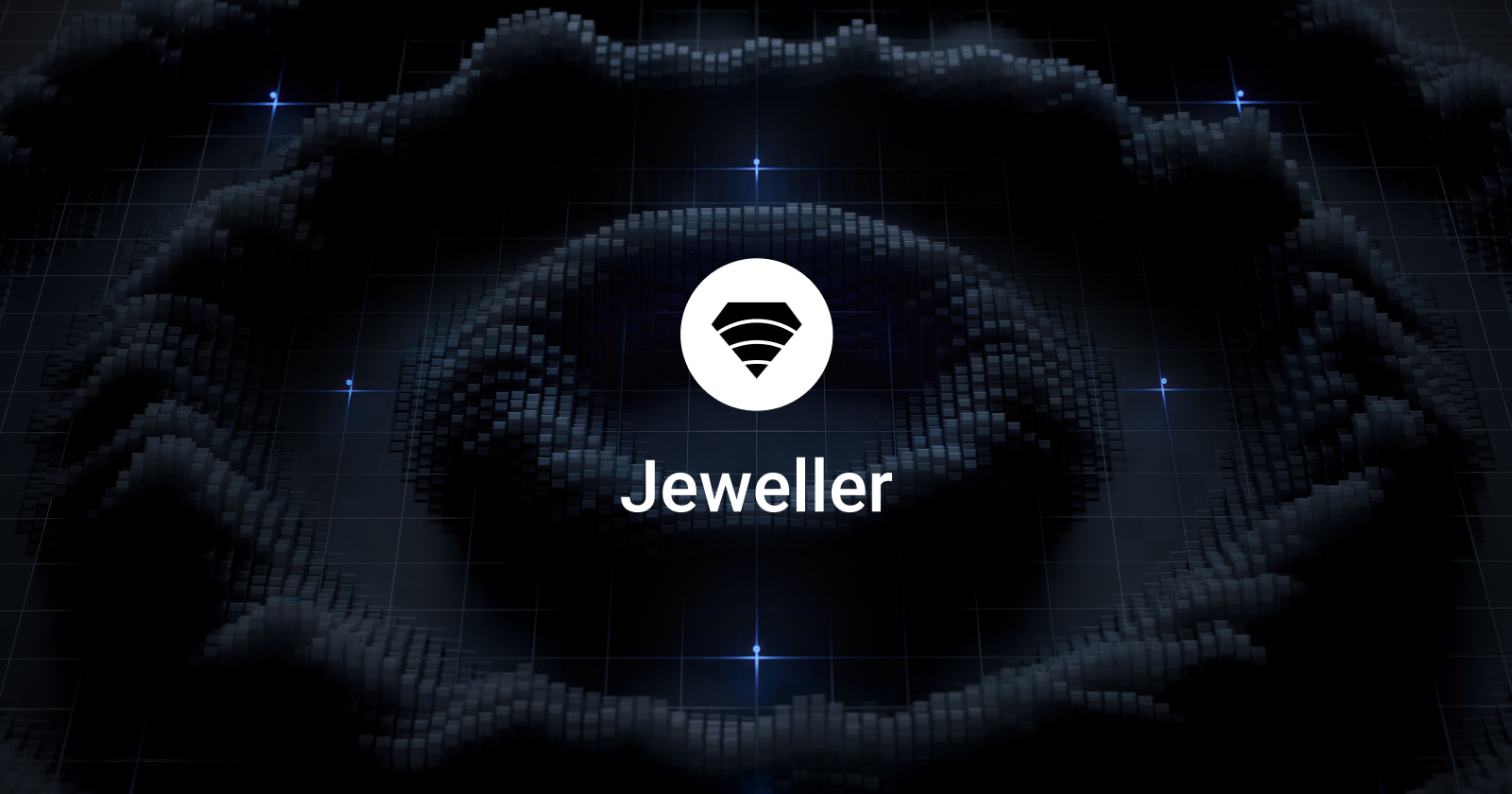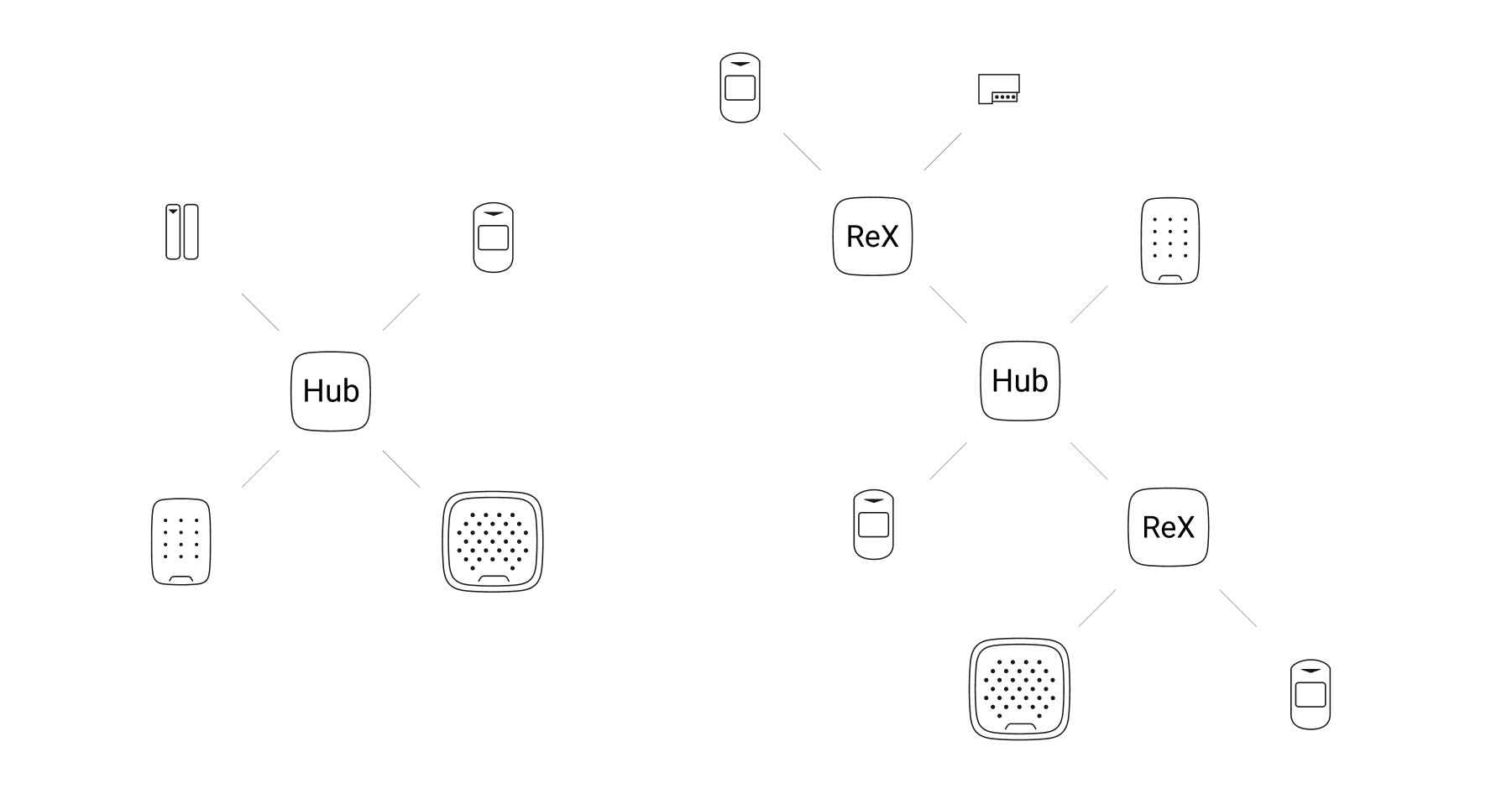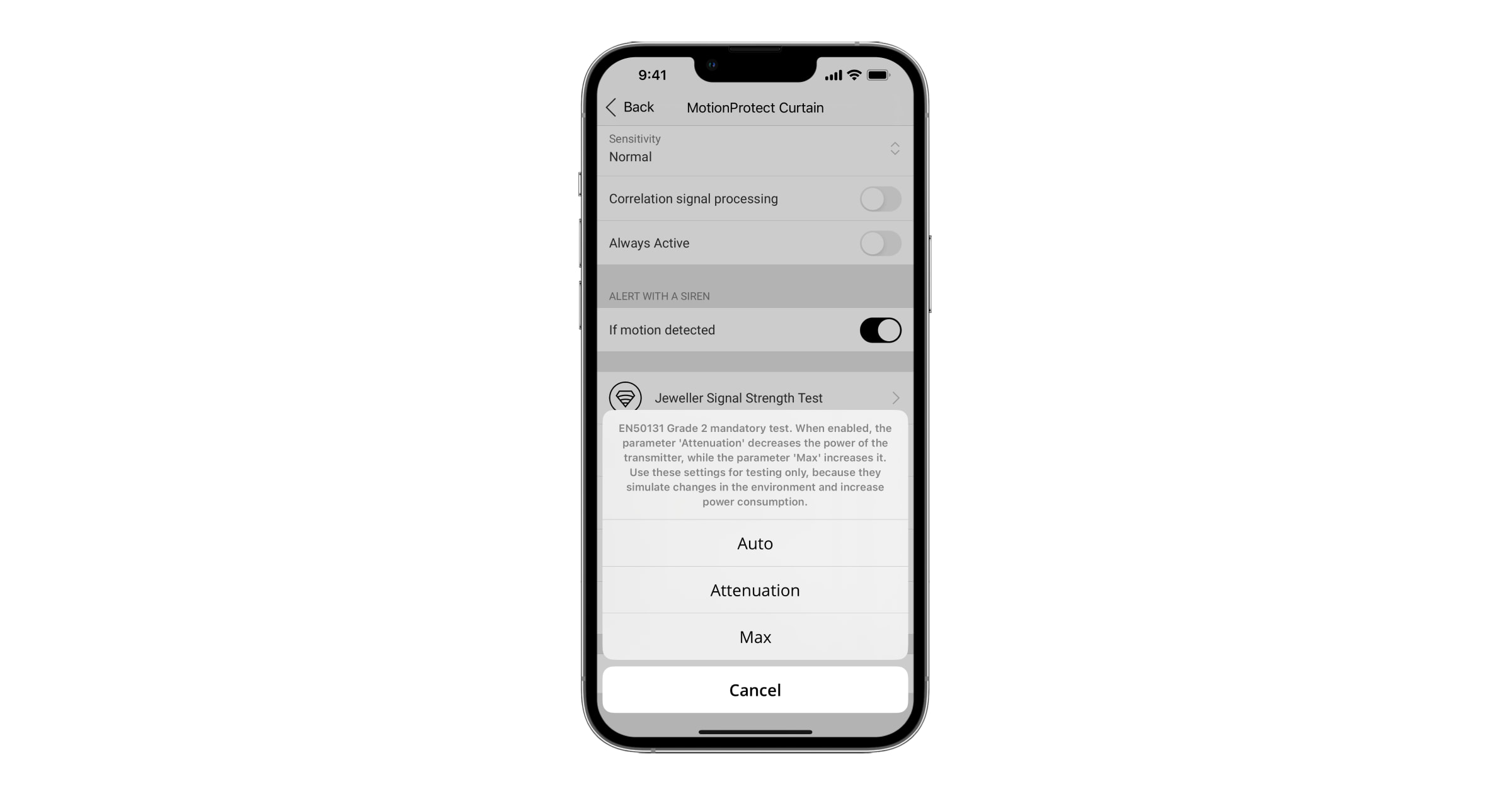Ajax system devices use two-way radio communication. The hub transmits commands, changes settings, and checks for devices on the network. The devices instantly transmit events and alarms via radio communication. Reliable communication is a key factor of the effectiveness of a security system and therefore requires the close attention of the installer.
This article describes what knowledge a specialist should have, how to build a security system installation process, and what points you need to pay attention to.
Ajax radio network structure
Ajax system devices communicate using the Jeweller proprietary two-way radio protocol. In parallel with Jeweller, Ajax devices can use the Wings or TurboWings radio protocols — it deals with transferring images from motion detectors with built-in cameras to compatible hubs. The radio network of the system is built around a hub (central panel), and if you need to increase the coverage area around the hub, you can use ReX Jeweller or ReX 2 Jeweller radio signal range extenders.
Up to 200 devices can work within the Ajax system, including 5 range extenders.
Jeweller, Wings, and TurboWings radio protocols use frequency bands that depend on the sales region:
- 866.0–866.5 MHz
- 868.0–868.6 MHz
- 868.7–869.2 MHz
- 905.0–926.5 MHz
- 915.85–926.5 MHz
- 921.0–922.0 MHz.
The maximum communication range between devices in an open space is 6,550 ft.
Range extenders communicate only with the hub — connecting the range extender to the range extender is not provided.
MotionCam series detectors do not support connection via range extender.
Before proceeding with the installation
It is necessary to understand the basic principles of radio communication and the factors that affect its stability. Knowing the specific characteristics and limitations of the electronics using radio communication is also essential.
How radio communication works
A detailed answer to this question is given on the Ajax radio protocols page. It spells out the key concepts: interference, diffraction, attenuation, absorption, and reflection of a signal by obstacles. Besides, there is a radio communication range calculator. The tool can be useful at the stage of preliminary planning of the installation and when proving to the client the need to purchase range extenders.

Explore the Ajax radio protocols page.
Knowledge of the radio communication potential and features of Ajax devices
The maximum radio communication range for two-way communication of devices is limited by the potential of the shorter range device. For example, if for Hub 2 Plus Jeweller it is 6,550 ft, and for KeyPad Plus Jeweller 5,550 ft, then the possible communication range maximum is 5,550 ft.

The communication range potential of Ajax devices is listed in printed manuals, on the product page and technical specifications on the official website, and in user manuals. The user manuals also list individual model features and recommendations common to all Ajax radio devices.
For example, it is not recommended to install wireless devices:
-
Сloser than within 3 ft of a hub or range extender.
- Near large metal objects and mirrors, as well as in metal boxes and cabinets.
- Near power cables, router, modem, and other similar electronics.
- Upside down or horizontally, if this installation method is not provided for by the design of the device.
And when choosing the installation locations for MotionCam motion detectors, it is recommended to maintain a distance of 3 ft or more between devices.
Read the user manuals for Ajax devices.
How to prepare for system installation
With the task of ensuring stable radio communication, the preparatory stage of the installation of the security system consists of communicating with the customer or another person who knows the specifics and plans for the facility use, as well as radio communication testing.
The radio communication testing stage is sometimes combined with the installation of system devices, but this is fraught with a waste of time, irrational use of devices, or even the need for re-installation. This is especially true for large sites and/or sites that are complicated in terms of radio communication.
Interview with the customer
It is important to find out how the protected facility will be used, especially if the system devices will be located within a large area, on several floors, or even in several buildings.
When ensuring the security of the territory, consider the possibility of parking cars as they can impede the propagation of radio waves and create zones without radio coverage.
If after the installation of the system, large non-radiotransparent or reflecting facilities appear in the building — mirrors, sliding wardrobes with mirror doors, metal cabinets, or shelves — then some detectors or even entire rooms may be left without communication. The customer should be warned about this.
By finding out the specifics of the protected facility use, you will reduce the likelihood of unstable system operation in the future.
Conduct radio communication testing at the facility
Radio communication testing involves the visit of an installer to the facility to determine the air noise level, identify dead zones, check the cellular communication quality, and the possibility of covering all locations of the protected facility that require control by the radio network of a security system.
What is needed for radio communication testing
For testing at the small facility, a hub and one Ajax device with support for the radio communication test mode are enough. As a rule, the GlassProtect Jeweller break detector is used — this is an Ajax detector with the smallest Jeweller maximum communication range of 3,250 ft.
If it is planned to use detectors with photo verification of alarms in the security system, a compatible hub and MotionCam motion detector to test the Wings radio protocol are needed.
ReX Jeweller or ReX 2 Jeweller radio signal range extenders are also used at large sites and/or sites potentially complicated in terms of radio communication.
How is radio communication testing carried out
The test hub is located at the optimal point with a minimum of obstacles to radio communication, with the possibility of connecting power, wired Internet; reliable Wi-Fi and cellular communications, and where the device will be out of sight. SIM cards from different mobile operators are installed in the hub.
The following hub states are evaluated in the Ajax app: Average noise (dBm) — the allowable level is below –80 dBm; Cellular signal strength of each SIM card — at least 2 bars and Wi-Fi signal strength.
The Jeweller signal strength test is run through the test detector settings menu. The facility has to be examined for 2–3 minutes with the detector in hand at all points where security system devices are supposed to be installed.
If part of the premises is not covered by radio communication, the test shows one bar, or the reception level is unstable, then the hub should be moved, or radio range extenders added to the system. When the hub is moved, retesting of radio communication is done at all points of device placement.
For security systems with photo verification of alarms, additional Wings signal strength tests are carried out.
Based on the results of radio communication testing, the list of security system devices is adjusted — the hub model is changed, radio signal range extenders and modules for integrating wired detectors are added (to ensure the safety of non-radiotransparent locations), where necessary.
| Hub (2G) Jeweller | Hub (4G) Jeweller | Hub Plus Jeweller | Hub 2 (2G) Jeweller | Hub 2 (4G) Jeweller | Hub 2 Plus Jeweller | Superior Hub Hybrid (2G) | Superior Hub Hybrid (4G) | |
| Devices | 100 | 100 | 150 | 100 | 100 | 200 | 100 | 100 |
| Photo verification | No | No | No | Yes | Yes | Yes | Yes | Yes |
| Range extenders | 1 | 1 | 5 | 5 | 5 | 5 | 5 | 5 |
| Wi-Fi | No | No | Yes | No | No | Yes | No | No |
| Cellular |
2G 1 × SIM |
4G (LTE) 1 × SIM |
2G/3G 2 × SIM |
2G 2 × SIM |
2G/3G/4G(LTE) 2 × SIM |
2G/3G/4G(LTE) 2 × SIM |
2G 2 × SIM |
2G/3G/4G(LTE) 2 × SIM |
The installer draws up a detailed scheme for the placement of devices on the site plan, and takes photos of the attachment points and locations, where necessary. If radio communication testing and installation are significantly separated in time, then the photos will make sure that there have been no changes at the facility that could affect radio communication.
Conduct radio communication testing at the facility in advance to determine the system configuration and significantly reduce the installation time.
What should be taken into account when installing to ensure stable radio communication
Ensuring that the situation at the site has not changed significantly and retesting of radio communication is not required, the installer proceeds to install the devices. The sequence of operations is not fundamental, and the locations of the devices are checked against the diagram and images drawn up in the process of radio communication testing.
Before fixing the device to the surface with screws or other reliable means of fastening, it is necessary to conduct a signal attenuation test simulating the appearance of new obstacles and changes in the situation at the facility. The device is temporarily secured with double-sided adhesive tape or ties, and then the “attenuation” test is run in the Ajax app. After testing, you need to reset the automatic power level setting of the radio transmitter.
If the signal attenuation test results are not satisfactory, the device is moved. If the situation does not improve, the hub should be moved, range extenders added to the system, or devices connected via wires.
If the hub is moved, the communication of all devices in the system is retested.
Devices are fixed to the surface with screws or other means of fastening only after successful testing of radio communication and detection zones.
Installer tips
- Be sure to read the user manuals for Ajax devices. It is also worth studying the materials of the Support section, training videos on the official YouTube channel — this will ensure against mistakes during editing and negative feedback from clients.
- Enhance and expand the capabilities of your project planning and device configuration through the use of Ajax web tools, designed to streamline your processes and improve overall efficiency.
- To rely on the radio communication only is not a good option for some facilities. For example, it is extremely difficult to provide stable radio communication in a metal hangar with metal racks on which metal parts are stored. Or to provide the radio communication coverage for basements with reinforced concrete walls and ceilings. Combine wireless devices with wired ones connected via integration modules or using Fibra devices.
Fibra devices are part of the Superior product line and are intended for high-profile projects. Only accredited Ajax Systems partners can sell, install, and administer Superior products. To get the accreditation, you have to complete a special Ajax Academy training program successfully.
- If the hub sends a notification about a high noise level after the system is installed, it is most likely that a device operating at Jeweller frequencies has been installed nearby and creates air noise. Or maybe, the communication at the facility is deliberately jammed. Contact the client.
- If all recommendations of this article have been taken into account, however, these tips fail to help and the system device suddenly loses communication or the communication level is unstable, but the noise level is normal, the problem may be in the device hardware. Contact the Ajax Systems technical support service.
- There is a notion that a low battery charge affects the communication quality of an Ajax device. It is a delusion. If there are any stability or reception level issues, look for other reasons.




